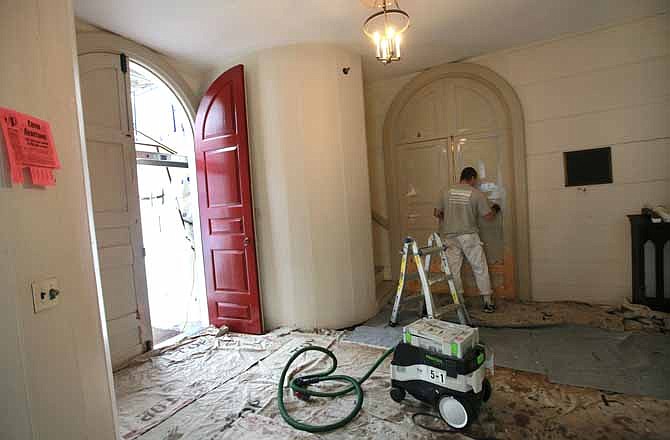CAMBRIDGE, Mass. (AP) - Since the 18th century, Christ Church Cambridge has survived more than just the rattling, pounding and drenching of New England weather.
It took a bullet, then worse, during the Revolutionary War because of the Tory loyalties of its founders. For several years after the war, the ransacked building's windows were open to the elements.
But the building endured and the church with it, eventually hosting a Sunday school teacher named Teddy Roosevelt, a press conference with the Rev. Martin Luther King Jr. and, soon, a celebration of its 250th year.
In preparation, this Episcopalian church in Harvard Square has undergone a painstaking exterior renovation aimed at preserving a building that offers a rare link to early America.
"It's about as important as they get," said Charles Sullivan, executive director of the Cambridge Historical Commission, referring to the buildings in his city. "It's been touched by so many events in American history."
The restoration was led by contractor and church member Charlie Allen. His affection for the building is clear as he explains his work, from repairing the wide siding boards to refurbishing the gold-leaf orb and cross atop its bell tower.
He marvels at the durability of wood, taken from an old growth white pine that was given time to grow slowly in the cold, leaving narrow growth rings and making it exceptionally strong. He shares a few tricks about keeping the building looking authentic. For instance, he'll add a few coats of paint to a newly replaced decorative triglyph so the surface doesn't look quite so crisp. His workers used a handsaw to leave marks on new siding boards that look similar to the marks on the old boards, which were cut by a vertically moving water saw.
At the back corner of the bell tower, he allows the lean of the building to show, so its front-facing section can appear square.
Allen says he always tries to put the building "at the table" during restorations, giving it a voice of sorts when choosing materials and techniques. Besides a desire to be safe from the weather, Christ Church has made one thing clear to him, Allen said.
"Don't we all want to look like we always used to?" he said with a smile.
Christ Church won't look exactly like it used to. The building, designed by famed Colonial architect Peter Harrison, opened Oct. 15, 1761, two years after Anglicans in Cambridge founded the congregation so they could attend a church closer than King's Chapel in Boston. The original members wanted to it look like a typical limestone church found in southern England. But, lacking the stone, it was painted tan and the boards were molded to look like masonry to resemble it as best it could.
Members decided the same look would be "quite of a leap of faith" today, Allen said. The new coat of platinum gray paint matches the traditional New England Colonial style, though few colonists welcomed the church when it first opened.
And as the Revolution approached, suspicions deepened about the wealthy Tory congregation and its loyalty to the British crown. The congregants were eventually forced to flee, and the building became a barracks across from Cambridge Common, where the Minutemen assembled before the Battle of Bunker Hull and during the Siege of Boston.
The church did hold a few notable services during the war years. In 1775, Martha Washington, an Anglican, arranged for a New Year's Eve service, which was also attended by her husband, George Washington, who would become president 14 years later. Then, in 1778, it opened for a funeral for a British prisoner of war who'd been accidentally killed. But this became an occasion for the church to be trashed by townspeople in a wave of anti-British sentiment.
The pulpit, pews and a communion table were destroyed, the windows were shattered and shots were fired - a bullet hole that remains inside is thought to have been left by the outburst.
The church sat empty and exposed to the elements until it reopened in 1790, then limped along for the next several years, partly as a home to Anglican and Episcopal Harvard University students who needed a place to fulfill the school's church attendance requirement.
Christ Church was reinvigorated by strong leadership in the mid-19th century, only to nearly be abandoned again. Around 1850, a group of parishioners pushed to tear down the building and move to a new location, Sullivan said. But another group prevailed after arguing for its preservation, based in part on its rich history, and more history was made there.
During Teddy Roosevelt's years at Harvard in the late 1800s, he was asked not to continue as a Sunday School teacher because he refused to become an Episcopalian. In 1967, the Rev. Martin Luther King was denied access to a Harvard building for a press conference to denounce the Vietnam War, so he held it at Christ Church instead.
The church won't disclose how much the exterior restoration cost, except to say it's six figures and wasn't the largest expense in a $2.5 million capital campaign.
Jonathan Austin, chairman of the church's property committee, said members feel a deep obligation to the generations that preserved the building. The 250th anniversary was an excuse to do as much as they could, as well as they could.
"We just want the building to look as good as it was designed to be," he said.

